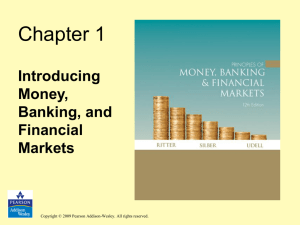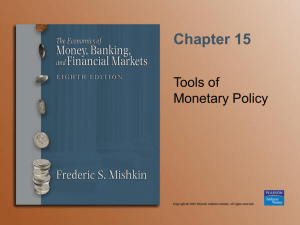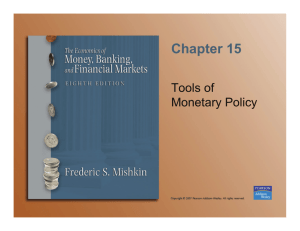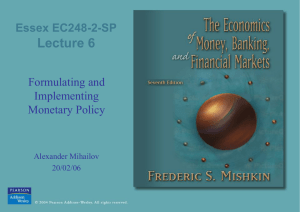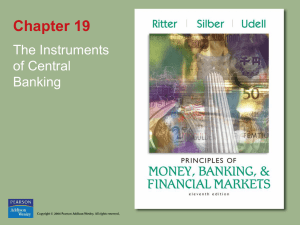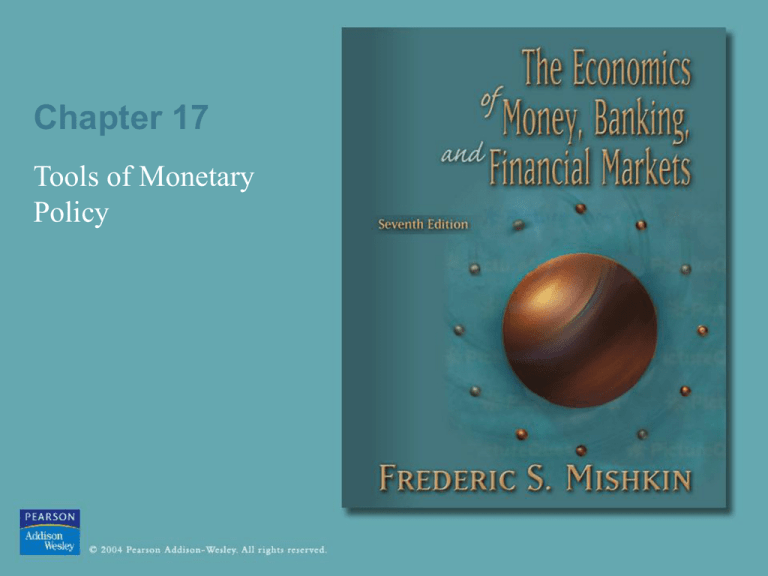
Chapter 17
Tools of Monetary
Policy
The Market for Reserves
and the Fed Funds Rate
Demand Curve for Reserves
1. R = RR + ER
2. i opportunity cost of ER, ER
3. Demand curve slopes down
Supply Curve for Reserves (two parts)
1. If iff is below id, then discount borrowing, Rs = Rn
2. Supply curve flat (infinitely elastic) at id because as iff
starts to go above id, banks borrow more at id
Market Equilibrium
Rd = Rs at i*ff
© 2004 Pearson Addison-Wesley. All rights reserved
17-2
Definitions
• Federal funds rate (or interbank rate): the interest
rate on overnight loans to reserves from on bank
to another, iff.
• Id: discount rate
• Rn: nonborrowed reserves
© 2004 Pearson Addison-Wesley. All rights reserved
17-3
Supply and Demand for Reserves
© 2004 Pearson Addison-Wesley. All rights reserved
17-4
Response to Open Market Operations
Open Market Purchase
Nonborrowed reserves,
Rn, and shifts
supply curve to
right Rs2: i to i2ff
© 2004 Pearson Addison-Wesley. All rights reserved
17-5
Response to a Change in the Discount Rate
(a) No discount lending Lower
Discount Rate
Horizontal to section and supply
curve just shortens, iff stays same
(b) Some discount lending
Lower Discount Rate
Horizontal section , iff to
i2ff = i2d
17-6
Response to Change in Required Reserves
Required reserve
Requirement
Demand for reserves ,
Rs shifts right and iff
to i2ff
© 2004 Pearson Addison-Wesley. All rights reserved
17-7
Open Market Operations
2 Types
1. Dynamic:
Meant to change MB
2. Defensive:
Meant to offset other factors affecting MB, typically
uses repos (and reverse repo).
Repurchase agreement: the Fed purchases securities
with an agreement that the seller will repurchase them
in a short period of time (1 to 15 days). A temporary
OMO.
© 2004 Pearson Addison-Wesley. All rights reserved
17-8
Open Market Operations
Advantages of Open Market Operations
1.Fed has complete control
2.Flexible (to any extend) and precise
3.Easily reversed
4.Implemented quickly (involve no adminstrative
delays)
© 2004 Pearson Addison-Wesley. All rights reserved
17-9
Discount Loans
3 Types
1. Primary Credit : standing lending facility, for healthy
banks; usually 100 basis points (one percentage point)
higher than the federal funds rate target. (see graph)
2. Secondary Credit: for banks that are in financial
trouble and experiencing sever liquidity problems; 50
basis points above the discount rate
3. Seasonal Credit: to meet the needs of a limited
number of small banks in vacation and agricultural
areas that have seasonal pattern of deposit.
© 2004 Pearson Addison-Wesley. All rights reserved
17-10
How Primary Credit Facility Puts Ceiling on iff
Rightward shift of Rs to
Rs2 moves equilibrium to
point 2 where i2ff = id and
discount lending rises
from zero to DL2
17-11
Discount Loans
Lender of Last Resort Function
1. To prevent banking panics
FDIC (Federal Deposit Insurance Corporation) fund
not big enough
Example: Continental Illinois (1984)
2. To prevent nonbank financial panics
Examples: 1987 stock market crash and September 11
terrorist incident
© 2004 Pearson Addison-Wesley. All rights reserved
17-12
Discount Policy
Advantages
1. Lender of Last Resort Role
cost: moral hazard problem; too big to fail
Disadvantages
1. Fluctuations in discount loans cause
unintended fluctuations in money supply
2. Not fully controlled by Fed
© 2004 Pearson Addison-Wesley. All rights reserved
17-13
Reserve Requirements (rarely used)
Advantages
1.Powerful effect
Disadvantages
1.Small changes have very large effect on Ms
2.Raising causes liquidity problems for banks
3.Frequent changes cause uncertainty for banks
4.Tax on banks
© 2004 Pearson Addison-Wesley. All rights reserved
17-14


